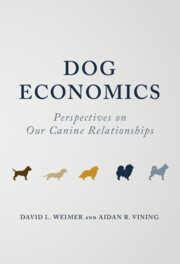Book contents
1 - Dogonomics
Homo Economicus versus Canem Amans
Published online by Cambridge University Press: 11 January 2024
Summary
In Chapter 1, we set out the big question that this book seeks to answer: How does economics help us understand the various relationships between human beings and dogs? We label our effort to answer this big question and the many related economic questions and issues as “dogonomics.” To frame the question, we introduce two somewhat differing economic perspectives: neoclassical economics, which assumes individual rationality, and behavioral economics, which argues that people act irrationally in predictable ways. We make the case that, although many dogs are bought and sold in markets, they are unlike other commodities and most other animals. Dog exceptionalism is real. Indeed, they often have a dual nature as both commodity and family member.
- Type
- Chapter
- Information
- Dog EconomicsPerspectives on Our Canine Relationships, pp. 1 - 12Publisher: Cambridge University PressPrint publication year: 2024

